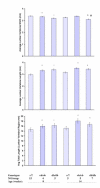Influences of obese (ob/ob) and diabetes (db/db) genotype mutations on lumber vertebral radiological and morphometric indices: skeletal deformation associated with dysregulated systemic glucometabolism
- PMID: 16451732
- PMCID: PMC1388216
- DOI: 10.1186/1471-2474-7-10
Influences of obese (ob/ob) and diabetes (db/db) genotype mutations on lumber vertebral radiological and morphometric indices: skeletal deformation associated with dysregulated systemic glucometabolism
Abstract
Background: Both diabetes and obesity syndromes are recognized to promote lumbar vertebral instability, premature osteodegeneration, exacerbate progressive osteoporosis and increase the propensity towards vertebral degeneration, instability and deformation in humans.
Methods: The influences of single-gene missense mutations, expressing either diabetes (db/db) or obese (ob/ob) metabolic syndromes on vertebral maturation and development in C57BL/KsJ mice were evaluated by radiological and macro-morphometric analysis of the resulting variances in osteodevelopment indices relative to control parameters between 8 and 16 weeks of age (syndrome onset @ 4 weeks), and the influences of low-dose 17-B-estradiol therapy on vertebral growth expression evaluated.
Results: Associated with the indicative genotypic obesity and hyper-glycemic/-insulinemic states, both db/db and ob/ob mutants demonstrated a significant (P < or = 0.05) elongation of total lumbar vertebrae column (VC) regional length, and individual lumbar vertebrae (LV1-5) lengths, relative to control VC and LV parameters. In contrast, LV1-5 width indices were suppressed in db/db and ob/ob mutants relative to control LV growth rates. Between 8 and 16 weeks of age, the suppressed LV1-5 width indices were sustained in both genotype mutant groups relative to control osteomaturation rates. The severity of LV1-5 width osteosuppression correlated with the severe systemic hyperglycemic and hypertriglyceridemic conditions sustained in ob/ob and db/db mutants. Low-dose 17-B-estradiol therapy (E2-HRx: 1.0 ug/ 0.1 ml oil s.c/3.5 days), initiated at 4 weeks of age (i.e., initial onset phase of db/db and ob/ob expressions) re-established control LV 1-5 width indices without influencing VC or LV lengths in db/db groups.
Conclusion: These data demonstrate that the abnormal systemic endometabolic states associated with the expression of db/db and ob/ob genomutation syndromes suppress LV 1-5 width osteomaturation rates, but enhanced development related VC and LV length expression, relative to control indices in a progressive manner similar to recognized human metabolic syndrome conditions. Therapeutic E2 modulation of the hyperglycemic component of diabetes-obesity syndrome protected the regional LV from the mutation-induced osteopenic width-growth suppression. These data suggest that these genotype mutation models may prove valuable for the evaluation of therapeutic methodologies suitable for the treatment of human diabetes- or obesity-influenced, LV degeneration-linked human conditions, which demonstrate amelioration from conventional replacement therapies following diagnosis of systemic syndrome-induced LV osteomaturation-associated deformations.
Figures



Similar articles
-
Influences of diabetes (db/db), obese (ob/ob) and dystrophic (dy/dy) genotype mutations on hind limb bone maturation: a morphometric, radiological and cytochemical indices analysis.Diabetes Obes Metab. 2007 May;9(3):311-22. doi: 10.1111/j.1463-1326.2006.00603.x. Diabetes Obes Metab. 2007. PMID: 17391157
-
Cytochemical analysis of pancreatic islet hypercytolipidemia following diabetes (db/db) and obese (ob/ob) mutation expression: influence of genomic background.Pathobiology. 2004;71(5):231-40. doi: 10.1159/000080056. Pathobiology. 2004. PMID: 15459481
-
Estrogenic restoration of functional pancreatic islet cytoarchitecture in diabetes (db/db) mutant C57BL/KsJ mice: relationship to estradiol localization, systemic glycemia, and persistent hyperinsulinemia.Cell Tissue Res. 2005 Feb;319(2):231-42. doi: 10.1007/s00441-004-1019-y. Epub 2004 Nov 20. Cell Tissue Res. 2005. PMID: 15654653
-
Hypercytolipidemia-induced cellular lipoapoptosis: cytostructural and endometabolic basis of progressive organo-involution following expression of diabetes (db/db) and obese (ob/ob) mutation syndromes.Prog Histochem Cytochem. 2006;40(4):181-231. doi: 10.1016/j.proghi.2006.02.002. Epub 2006 Mar 30. Prog Histochem Cytochem. 2006. PMID: 16765720 Review.
-
[Genetic mice models of type 2 diabetes for evaluation of the effectiveness of minor biologically active food substances].Vopr Pitan. 2015;84(6):63-8. Vopr Pitan. 2015. PMID: 29378099 Review. Russian.
Cited by
-
Effect of obesity and low back pain on spinal mobility: a cross sectional study in women.J Neuroeng Rehabil. 2010 Jan 18;7:3. doi: 10.1186/1743-0003-7-3. J Neuroeng Rehabil. 2010. PMID: 20082692 Free PMC article.
-
Long-duration leptin transgene expression in dorsal vagal complex does not alter bone parameters in female Sprague Dawley rats.Bone Rep. 2024 Apr 24;21:101769. doi: 10.1016/j.bonr.2024.101769. eCollection 2024 Jun. Bone Rep. 2024. PMID: 38706522 Free PMC article.
-
Vertebral body integrity: a review of various anatomical factors involved in the lumbar region.Osteoporos Int. 2007 Jul;18(7):891-903. doi: 10.1007/s00198-007-0373-5. Epub 2007 Apr 3. Osteoporos Int. 2007. PMID: 17404781 Review.
-
Leptin's metabolic and immune functions can be uncoupled at the ligand/receptor interaction level.Cell Mol Life Sci. 2015 Feb;72(3):629-644. doi: 10.1007/s00018-014-1697-x. Epub 2014 Aug 7. Cell Mol Life Sci. 2015. PMID: 25098352 Free PMC article.
-
Intervertebral disc degeneration in mice with type II diabetes induced by leptin receptor deficiency.BMC Musculoskelet Disord. 2020 Feb 5;21(1):77. doi: 10.1186/s12891-020-3091-1. BMC Musculoskelet Disord. 2020. PMID: 32024487 Free PMC article.
References
-
- Levin M, Boisseau V, Avioli L. Effects of diabetes mellitus on bone mass in juvenile and adult-onset diabetes. N Engl J Med. 1976;294:241–245. - PubMed
MeSH terms
Substances
LinkOut - more resources
Full Text Sources
Medical
Miscellaneous

